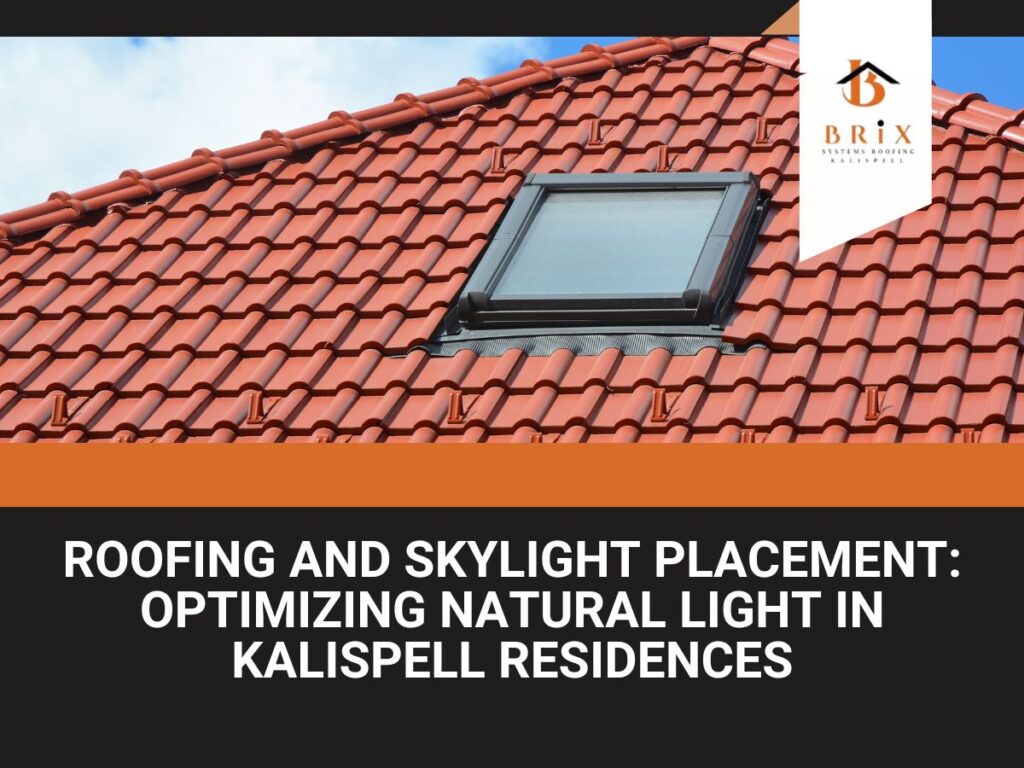
If you want to add something worthwhile and beautiful to your house, installing skylights is something you should consider. They boost your home's energy efficiency, add aesthetic appeal, and let in an abundance of natural light.
A single skylight installation might add about 30% more light to your space than a standard window could. You may effortlessly light your room during the day without using energy-guzzling standard lights by strategically placing skylights.
But it's not as easy as just locating a place on the roof and nailing in a skylight. To get the greatest results and require the least amount of repair and maintenance, you must take into account a number of criteria and take specific precautions during the installation process. Let's look at roofing and skylight placement.
Throughout the year, the sun’s position in the sky shifts, influencing the amount and intensity of sunlight that enters a home.
What does this mean? In Kalispell, for maximum sunlight during all seasonal changes in the direction of the sun, the skylight angles need to be considered.
Ideally, skylights should be oriented to capture the sun’s rays effectively throughout the year, taking into account both summer and winter paths of the sun.
Several conditions must be considered when placing skylights to ensure they perform optimally. Careful consideration must be given to the potential for overheating and the need for shading solutions during peak summer months.
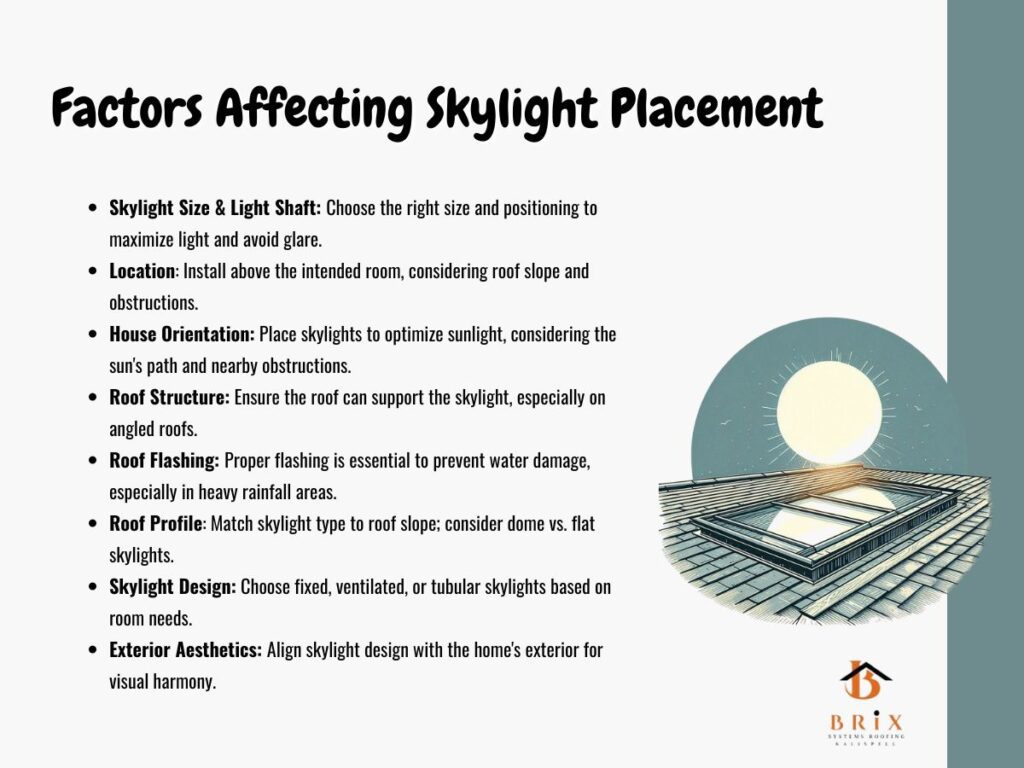
The amount of light that enters the room depends on the angle at which the skylight is positioned. The ideal location for the light shaft is one that maximizes illumination in the intended region without producing glare.
Consider your skylight's size to ensure that it is appropriate in terms of proportion for the space. When choosing the size, consider the width and height of the ceiling in the space.
If your room has a flat ceiling and the roof slopes toward an exterior wall, installing the skylight closer to the wall will result in a smaller light shaft but more effective illumination.
When thinking of where to install skylights, choose a specific room you want to light ideally one below the roof. This can be a dark attic or the upstairs bedroom or even the study.
Ask your installer to focus on a portion of the roof above that space that satisfies the skylight's minimum slope specifications as specified by the manufacturer. Installing a skylight typically involves sloping the roof five to fifteen degrees above your latitude.
Make sure you put into consideration the direction of the skylight. Avoid positioning skylights where your view would be blocked by the walls of a taller nearby building or other obstructions like tall trees.
Skylights don't offer the same amount of light as artificial lighting like a bulb. The amount of light is dependent on its placement so you need to ensure that your skylight is installed in the direction that maximizes this.
The orientation of your home relative to the sun's direction comes into play when determinig which placement works best. Although west and east facing skylights also function well, south-looking skylights in Kalispell are generally the most efficient since they receive direct sunlight throughout the day.
Space planning before installing the skylights is also imporant since the pacement of a fixture or furniture might obstruct the direct path of sunlight. Tall trees, especially those with thick foliage can also obstruct the direct path of sunlight entering your room unless you want some shade through the skylight.
Your home's roof structure has an impact on how safe and secure your skylight installation will be. You must make sure that the roof can sustain the weight of the skylight.
A skylight can be readily retrofitted into a flat roof, but if your roof is inclined, you may need to take some additional precautions. You have to make sure that a skylight is sealed properly with caucking when putting it on an angled roof.
To support the additional weight and potential stress brought on by the skylights, the roof framework must be strengthened. Sometimes, extra support beams or trusses are required to preserve the integrity of the roof, particularly when there are larger skylights.
The most important component in installing skylights is flashing. Water intrusion and other installation-related issues must be avoided at all costs.
The skylight flashing should overlap the shingles and roof membrane to cover the entire opening. It also needs to be treated with a waterproof sealant and put underneath the roofing material.
In places like Kalispell, Montana, where there is a lot of snowfall or rain, proper roof flashing installation is important. The integrity of the flashing is essential in these temperatures to avoid water buildup and ice dams around the skylight, which over time can cause serious damage.
Your roof profile will dictate the amount of work needed during your skylight installation. This is also determined by the type of skylight and its shape.
The benefit of modern skylights is that they can be fitted on any roof, regardless of slope, because they come with flashing skits. There are two types of skylights available to buyers: dome and flat.
The majority of homes have flat skylights, but if there are trees over your roof, falling leaves and debris could easily obstruct your view. Domed skylights solve this problem by allowing debris to fall to the side, although their installation is more difficult.
Maximizing the advantages of natural light requires selecting the correct kind of skylight and placing it in the best possible location. A home's rooms should have different amounts of light, so the location of skylights should be adjusted accordingly.
Glass and plastic skylights are among the different designs that are offered. Glass skylights are more costly than plastic skylights in terms of price and don't scratch easily.
Glass skylights are a viable option because they often retain their clarity for a long time. Over time, their plastic counterparts become discolored, compromising the vision.
The majority of homeowners consider how the skylight will look from the inside when deciding where to put them. It often escapes them that the positioning of skylights can also significantly affect the outside of the house.
This is particularly true for historic homes that were not intended to have skylights installed. A poorly built skylight could be quite damaging if you ever intend to sell your house.
Therefore, make sure the skylights you choose for your home blend in with the outside design of the building.
When it comes to optimizing the placement of skylights, each room in a home has unique needs and considerations. The goal is to enhance natural light where it’s most beneficial while ensuring comfort and functionality.
Living rooms and dining areas are central gathering spaces in a home, where natural light can create a warm and inviting atmosphere. Placing skylights in the central part of the ceiling can distribute light evenly throughout the room, reducing the need for artificial lighting during the day.
For larger living areas, multiple skylights or a combination of skylights and large windows can ensure consistent lighting. In dining areas, skylights positioned directly above the dining table can create a pleasant and naturally lit environment for meals and entertaining.
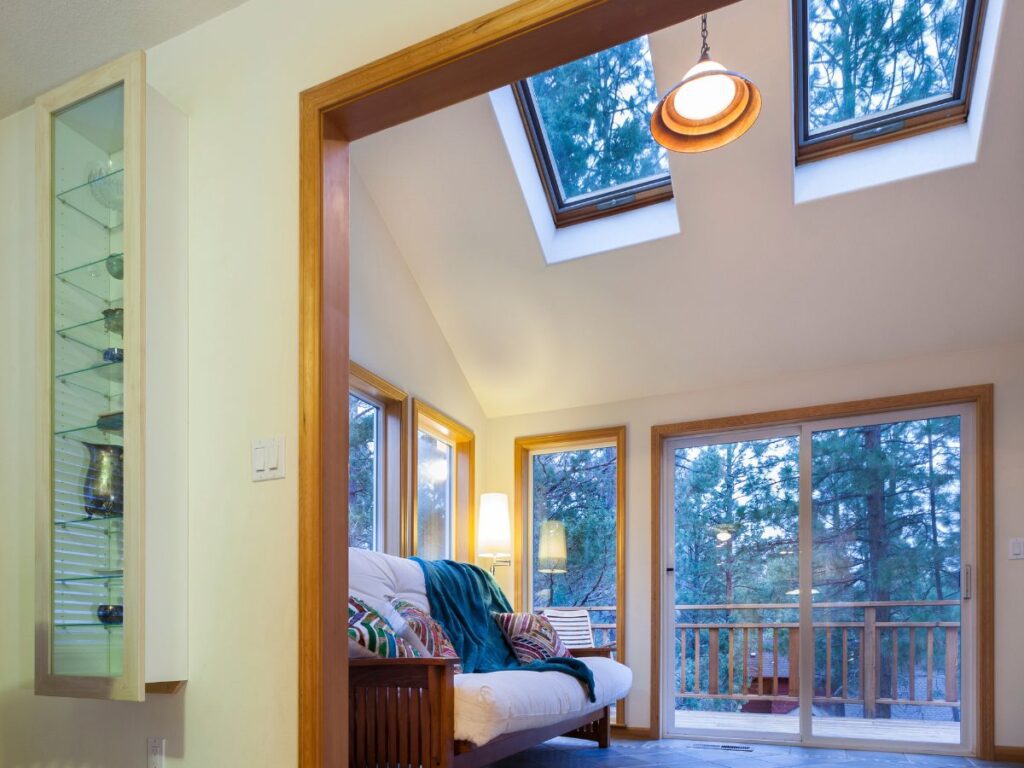
Kitchens benefit greatly from natural light, particularly in work areas such as countertops, islands, and sinks. Skylights installed above these areas can provide focused, bright light that enhances visibility and makes food preparation safer and more enjoyable.
Ventilated skylights are especially useful in kitchens, as they can help with ventilation, reducing heat and cooking odors. Placing skylights above or near the stove can also help to disperse steam and smoke, maintaining a fresh and comfortable kitchen environment.
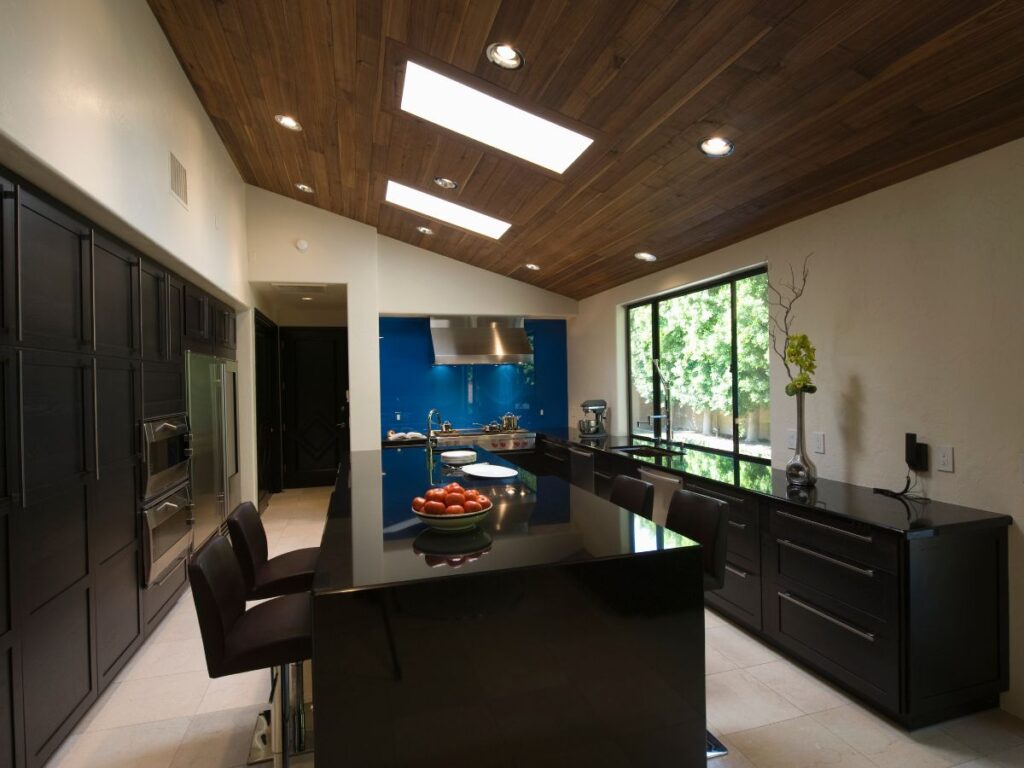
In bathrooms, skylights can offer both functional and aesthetic benefits. Positioned near mirrors or vanity areas, skylights provide natural lighting that enhances visibility for grooming tasks such as shaving and applying makeup.
The soft, diffused light from skylights can create a spa-like ambiance, making bathrooms feel more luxurious and serene. Ventilated skylights are particularly beneficial in bathrooms to help reduce moisture and prevent mold and mildew, especially in areas with high humidity like shower stalls.
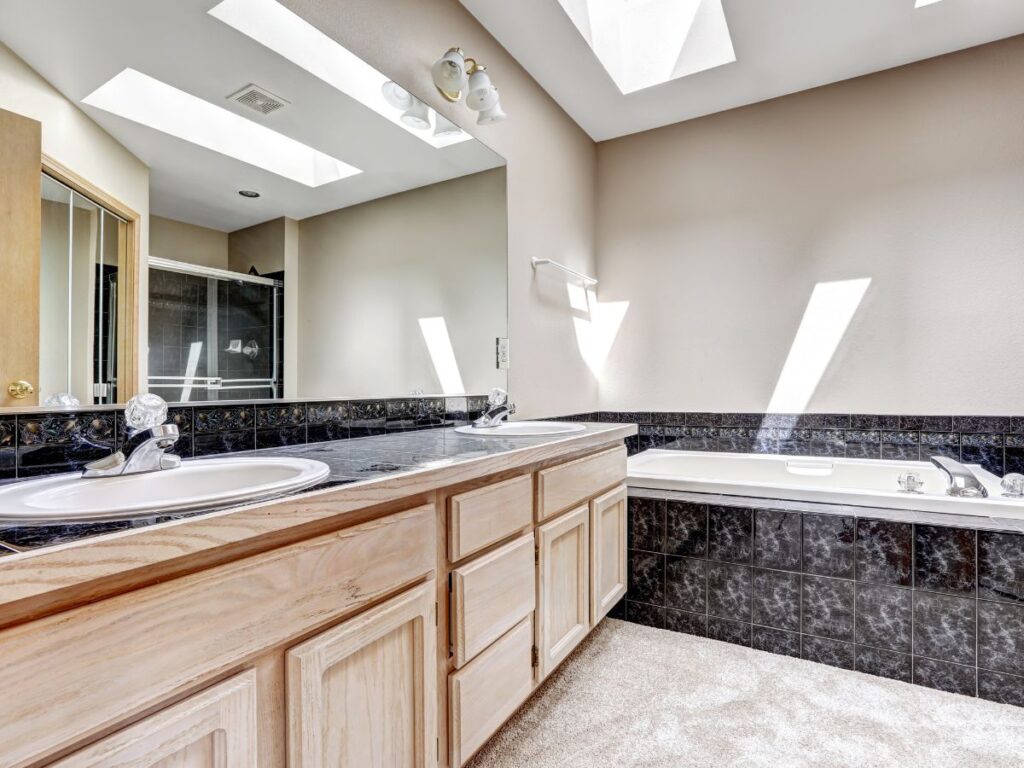
Bedrooms can greatly benefit from the inclusion of skylights, particularly when they are positioned to capture the morning sun. Skylights oriented towards the east can allow the gentle morning light to enter, helping to regulate sleep patterns and promoting a natural wake-up routine.
In children's bedrooms, skylights can make the room feel more open and cheerful. For those who prefer a dark sleeping environment, skylights with built-in shades or blinds can offer flexibility, allowing for darkness at night and light during the day.
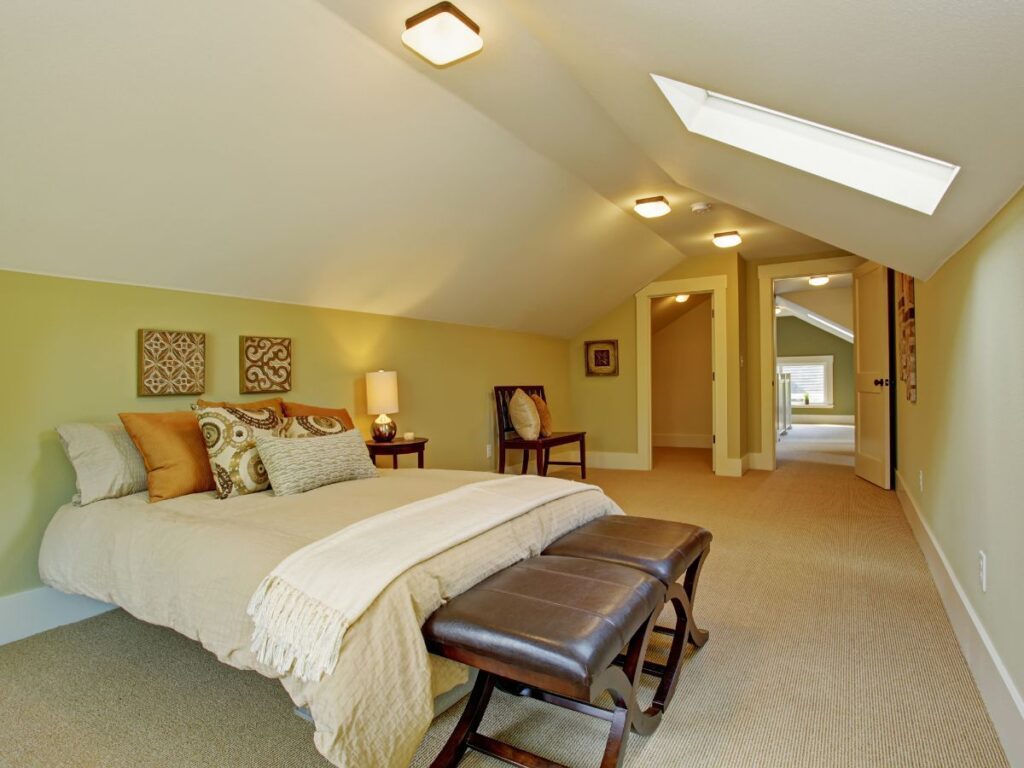
Hallways and stairwells are often the darkest areas in a home, typically receiving little to no natural light. Installing skylights in these spaces can transform them, making them feel more open and less confined.
Tubular skylights, which use reflective tubes to direct light into small or narrow spaces, are particularly effective for hallways and stairwells. These skylights can brighten up these transitional areas, enhancing safety and visibility, and making the overall home feel more connected and welcoming.
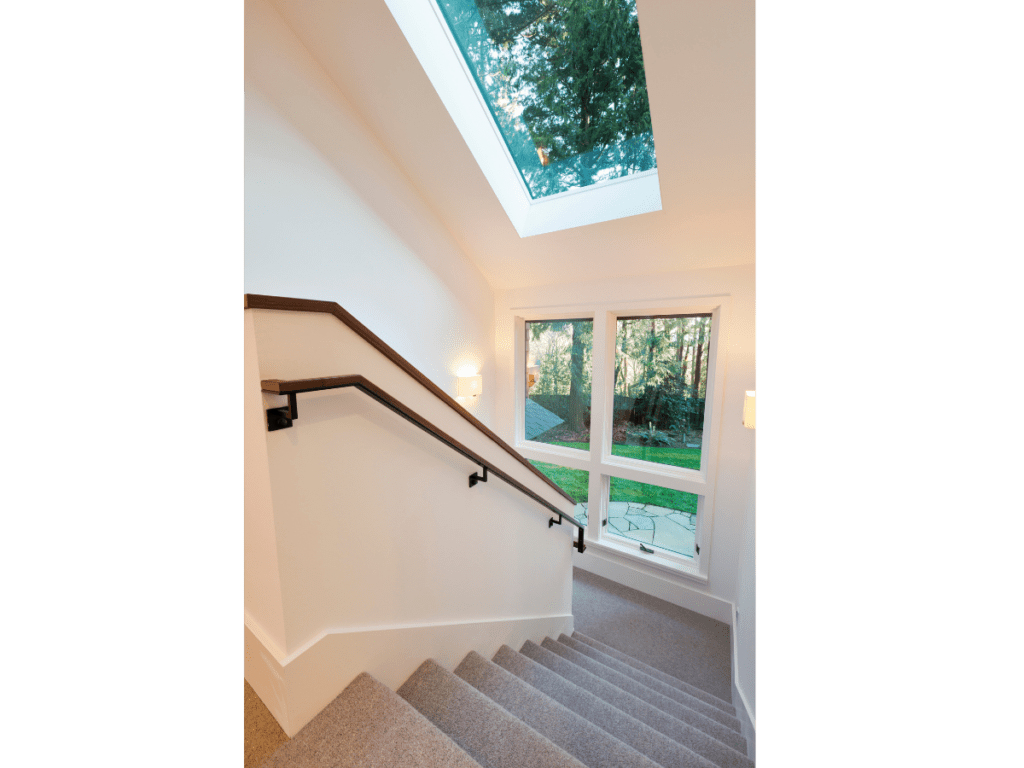
For home offices and studios, natural light is crucial for creating an environment that promotes productivity and creativity. Skylights can be positioned to provide balanced, indirect light that reduces eye strain and enhances focus.
In art studios or craft rooms, skylights can offer the natural light necessary for detailed work, improving color accuracy and visibility. Ventilated skylights can also help maintain a comfortable temperature in these workspaces, ensuring a pleasant and productive atmosphere.
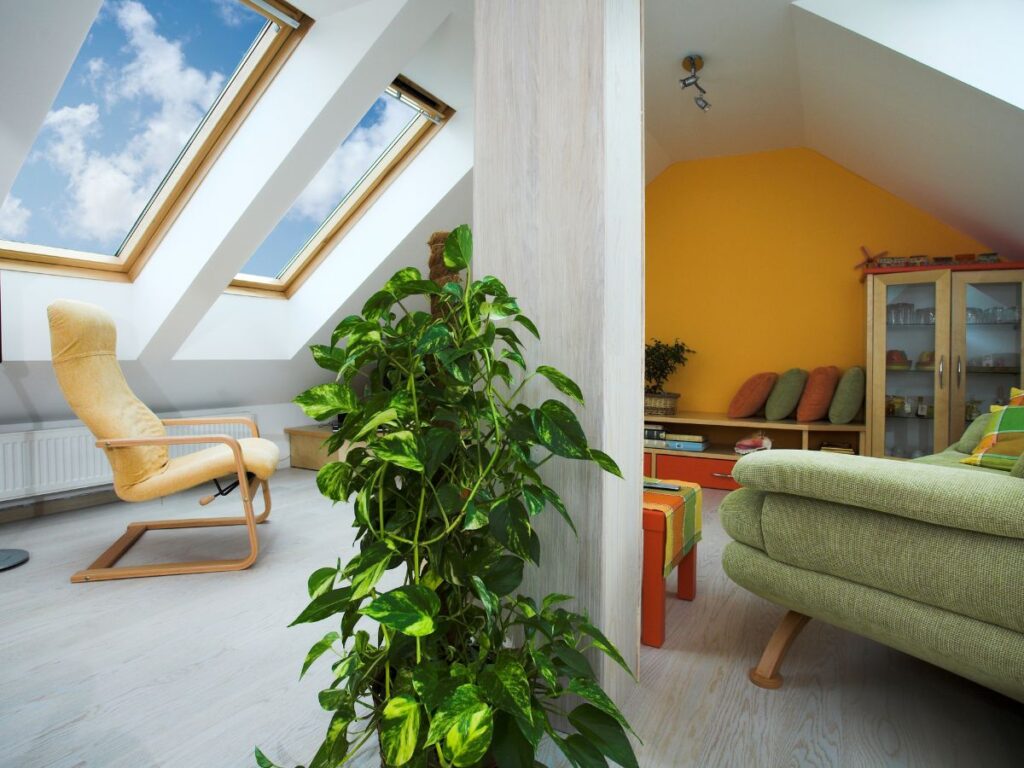
Skylight installation can be completed more affordably by DIYers with carpentry and roofing skills, thanks to the availability of skylights with flashing included. However, the complexity of installation and the possibility of falling or causing a leak in the roof make expert installation well worth the extra cost for the average DIY enthusiast.
If one were to DIY the installation of a skylight, it would require removing the roof cladding and cutting a hole in the roof. Along with installing the skylight and flashing, it also entails patching up sections of the ceiling and roof above and below the skylight.
This brings to term the importance of roofing saftey protocols to prevent injuries as well as damage to your roof through installation errors that could lead to roof leaks. The more informed homeowners are on roof safety the better they'll take care of their health and homes.